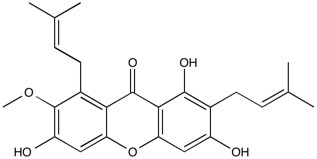α-Mangostin | STING agonist (human)
NMR (Conforms)

Available Options
| Size: | Price | Quantity | |
|---|---|---|---|
| 10 mg | $45.00 | ||
| 50 mg | $150.00 |
α-Mangostin (6147-11-1) is a xanthone natural product that has historically been used in traditional folk medicine.1 It is a potent agonist of human STING (Stimulator of Interferon Genes) and also weakly activates mouse STING.2 Induces IFN-β production and repolarizes human monocyte-derived M2 macrophages to M1. Improves insulin secretion and protects INS-1 cells from streptozotocin-induced damage.3 Suppresses the metastasis of human renal carcinoma cells.4 Synergizes with kinase inhibitors in suppression of proliferation of SK-MEL-2 malignant melanoma cells.5
References/Citations:
1) Mohan et al. (2018), An anti-inflammatory molecular mechanism of action of α-mangostin, the major xanthone from the pericarp of Garcinia mangostana: an in silico, in vitro and in vivo approach; Food Funct., 9 3860
2) Zhang et al. (2018), Identification of α-Mangostin as an Agonist of Human STING; Chem. Med. Chem., 13 2057
3) Lee et al. (2018), Alpha-Mangostin Improves Insulin Secretion and Protects INS-1 Cells from Streptozotocin-induced Damage; J. Mol. Sci., 19 E1484
4) Chen et al. (2017), Alpha-Mangostin Suppresses the Metastasis of Human renal Carcinoma Cells by Targeting MEK/ERK Expression and MMP-9 Transcription Activity; Cell Physiol. Biochem., 44 1460
5) Xia and Sun (2018), Synergistic inhibition of cell proliferation by combined targeting with kinase inhibitors and dietary xanthone is a promising strategy for melanoma treatment; Clin. Exp. Dermatol., 43 149
NMR (Conforms)
Safety Data Sheet:
Product Data Sheet:
Materials provided by Focus Biomolecules are for laboratory research use only and are not intended for human or veterinary applications. Please note that we do not sell to individuals and that all orders placed by non-research organizations will incur a $20 restocking/refund fee
α-Mangostin (6147-11-1) is a xanthone natural product that has historically been used in traditional folk medicine.1 It is a potent agonist of human STING (Stimulator of Interferon Genes) and also weakly activates mouse STING.2 Induces IFN-β production and repolarizes human monocyte-derived M2 macrophages to M1. Improves insulin secretion and protects INS-1 cells from streptozotocin-induced damage.3 Suppresses the metastasis of human renal carcinoma cells.4 Synergizes with kinase inhibitors in suppression of proliferation of SK-MEL-2 malignant melanoma cells.5
References/Citations:
1) Mohan et al. (2018), An anti-inflammatory molecular mechanism of action of α-mangostin, the major xanthone from the pericarp of Garcinia mangostana: an in silico, in vitro and in vivo approach; Food Funct., 9 3860
2) Zhang et al. (2018), Identification of α-Mangostin as an Agonist of Human STING; Chem. Med. Chem., 13 2057
3) Lee et al. (2018), Alpha-Mangostin Improves Insulin Secretion and Protects INS-1 Cells from Streptozotocin-induced Damage; J. Mol. Sci., 19 E1484
4) Chen et al. (2017), Alpha-Mangostin Suppresses the Metastasis of Human renal Carcinoma Cells by Targeting MEK/ERK Expression and MMP-9 Transcription Activity; Cell Physiol. Biochem., 44 1460
5) Xia and Sun (2018), Synergistic inhibition of cell proliferation by combined targeting with kinase inhibitors and dietary xanthone is a promising strategy for melanoma treatment; Clin. Exp. Dermatol., 43 149
Related STING Products
Download
Calculate the molar concentration, mass or volume in a solution.
Concentration × Volume × Molecular Weight = Mass
Focus Biomolecules • Plymouth Meeting, PA USA • 1-855-FOCUS21
Focus Biomolecules
Plymouth Meeting, PA USA
1-855-FOCUS21
Website Created by Advanta Advertising LLC.

